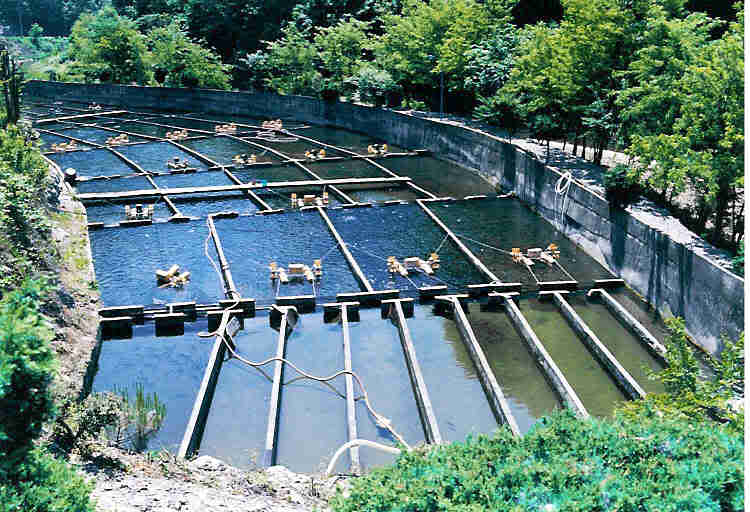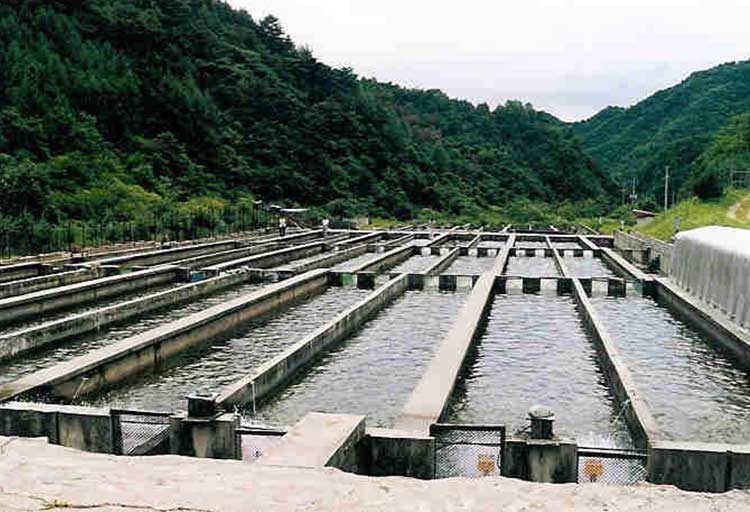Water treatment for fish
Aquaculture is the use of circulatory system dates back nearly two decades, that was used for the first time in Denmark and now in European countries (in particular) is used. reactors blender and sterilization, water is restored and re-used. Such a delicacy causes the water quality control is done permanently and stop doing it without the slightest act of purification. That's why automation plays an important role in healthy such a system. After measuring the critical factors in fish water used, the data obtained are analyzed. Such a requirement makes the industry an important role in measuring and analyzing factors and correcting them. Temperature control is another important factor that decreases the breeding period.
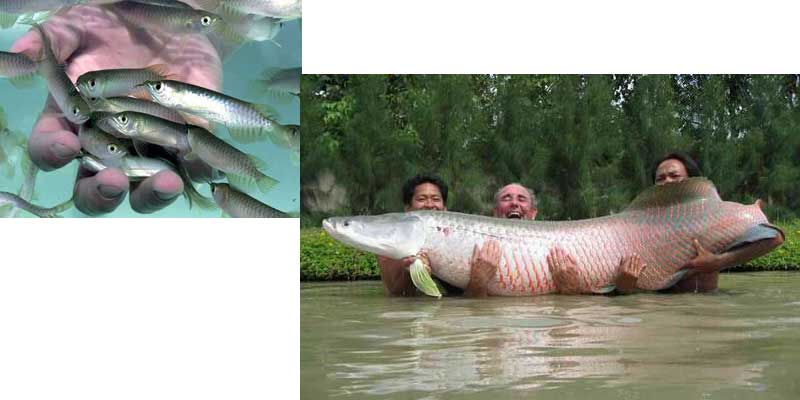
In this system, the required factors feed the fish on favorable terms. CCTV system components include: a concrete pool, microfilter, circulation pump, biological filter, air lines, liquid oxygen injection cone, control room, engine generators, X-uv, automatic feeders and ozone .... The overall goal in a closed system aquaculture, water reuse and increase the density of fish in the ponds. brings. For example, in a trout farm with a capacity of 50 tons, the amount of fresh water required 500 liters per second and pool area as well as five thousand square meters, but in a circulating water system with the same capacity, the water used to Seven LPs and pool area was reduced to 250 square meters. Performance-based CCTV system for fish in the pool water circulation and regenerate it in terms of oxygen, waste removal, elimination of toxins, regulating the PH and disinfection.
Increase production efficiency in aquaculture using ozone generators
The use of ozone in the aquaculture industry to improve the level of annual production and increase the production per unit area, was effective and positive results in studies conducted proved to be.
Some applications of ozone in fish ponds are:
- Disinfection and water purification and proliferation of fish farms
- Help coagulation and settling or filtration
- Used in CCTV systems instead of uv
- Efficient use of water in case water circulation
- Loss of fish diseases and cip Pools
- Excess ammonia and nitrite oxide
- Increasing the amount of oxygen dissolved in water
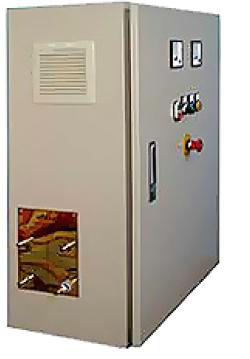
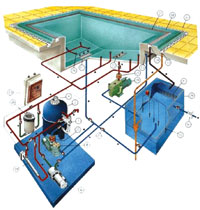
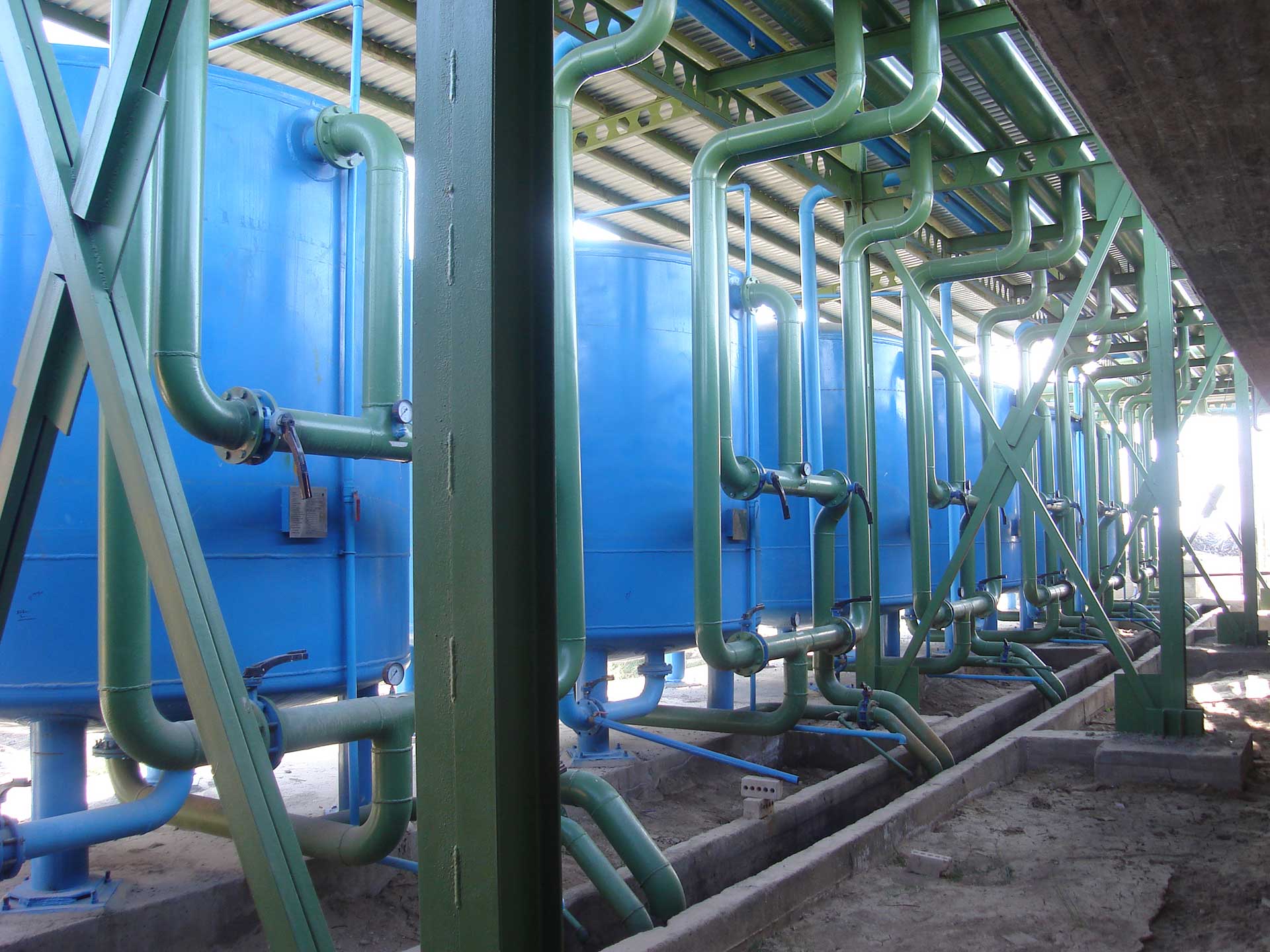
will be long. in this device, water containing suspended particles from the substrate of silica pass through. The water passes through the pores of the silica particles, suspended material in the water almost free of suspended solids stuck achieved. The accumulation of particulate matter in the pores of the filter pressure drop is increased if the pressure exceeds a certain threshold, should wash the filter .
The use of sand filter devices : A water purification units rivers with high turbidity after coagulation, flocculation and sedimentation to prepare drinking water, sanitary and industrial (B) to prevent turbid water pool for water purification and clarification of C: Final purification of domestic and industrial waste (D) cooling tower water treatment from suspended matter from air to water penetration, such as dust
Building sand filter (pressure) oil is covered with color temperature and color Zynkrych. These filters both vertically and horizontally structured.
Further Details:
Growth and ever-increasing world population, food security and access to new food resources to address today is one of the most important human concerns. A selection strategies to meet food needs and in particular human protein, fish, especially cold-water fish such as Qzlalast. This requires work, their knowledge about the biological needs of fish and Zmynhsaz·hay growth and weight gain recognition and is more production per unit area. This important issue, but with access to the latest findings and the latest information obtained in this industry will not be possible. 1ـ Temperatures
Water temperature is an environmental factor that has the greatest effect on the fish. It is thought that the temperature factor in the first attempt to create a project is commercially aquaculture.
Set the water temperature in the pools is impractical to do so in the geographical areas the growing season is too long you will need to fish at a convenient time to reach market weight.
Temperature in the amount of dissolved oxygen is effective. The optimum temperature for growth, the temperature is selected if the fish has the power to adopt her. Temperatures outside the range provides the optimal compression stress in fish nutrition, growth, reproduction and disease prevention will be reflected. The likelihood of success in fish farming close to optimum temperature is higher.
Every 10 ° C increase in temperature, the amount of oxygenated Rainbow Trout and 7.2 times higher than normal, which means that the fish seems to get 7.2 times more oxygen than usual to operate.
The optimum temperature for growth and development of rainbow trout between 15 and 17 ° C. At this temperature, Rainbow Trout maximum ability to digest and absorb food and has the highest enzyme activity and lower temperatures, some of the fish decreased enzyme activity and affect fish growth. You should also know that lethal for trout and salmon low around -5 ° C. At temperatures above 20 ° C the water of oxygen is limited, because the concentration of dissolved oxygen in water decreases with increasing temperature. In such a case, to minimize fish need oxygen, it must be kept hungry.
Generally, the proper temperature for spawning behavior, incubation and development of fish to fish growth is lower than the appropriate temperature. The maximum and minimum temperatures that it is able to handle fish are genetically determined. To select the appropriate place for fish according to water quality and quantity, the most important issue that must be considered. It is best to use a spring that its temperature is not changed, should be used.
ـ The effect of temperature on resistance to disease:
With increasing water temperature in fish immune response in the cellar and warm water fish increases. In contrast to very low temperatures to warm water fish weakens the immune response, whereas in cold-water fish only delay the onset and reduce the severity of it will be answered. The severity of infectious diseases caused by bacteria Grmmnfy often when raising the water temperature increases. In this case, the average time between infection and increased mortality occurs before death will be short. However, higher temperatures water is not exclusively for the benefit of pathogens. May metabolism and increase the rate of cell division in higher temperatures but also expedited tissue repair. Find Flex ideal temperature of pathogens such as Baktrsyklvfylvs (Bymarybaktryayy free cold water fish) for growth and reproduction was lower than their hosts with cooling water may reduce the rate of mortality. However, long-term mortality after an incubation period will occur. Many pathogens are like cold fish
(Like Vybryvangvtylarvm) and therefore capable of cell division partially water at very low temperatures (the host immune system weakens protection) will be. For example, Vibrio metabolism and cell division at a temperature higher than 15 ° C so fast that easily overcome the host's immune system.
At temperatures less than 12 ° C water, microbial growth rates will weaken the way that may protect fish immune system than it is to overcome.
degree temperatures 12 to 15 degrees Celsius intermediate may be minor factors such as fish physiological conditions, the degree of physiological stress and mucosal lining of perfection, are decisive result. Probably in the range of temperatures is more aggressive than the importance of the number of microbial cells (Grvbrg et al. 1982).
Very clear effects on health and resistance to disease can be regarded as a fish for the duration of the contract Tvlanytht thermal regimes are less than the fish.
۲-(DO) ـ Dissolved oxygen
7 mg of oxygen per liter and favorable for cold-water fish for warm water fish is 4 mg per liter. At least oxygen that fish can tolerate depends on how long the shortage of oxygen. For example, fish may tolerate a few hours of oxygen concentration of 5.0 mg per liter. The oxygen deficiency affect the species, age and size of fish and physiological conditions, the concentration of soluble salts and so on. Supersaturated oxygen concentration of the air bubble and mortality. In this case, the air bubbles around the gill cover.
Workshops and farms, fisheries management success by maintaining the oxygen concentration is in good condition. In the high-intensity culture, oxygen and fresh water be provided by aeration and under culture conditions suitable replacements semi dense water can help to supply oxygen. Besides the importance of breathing and oxygen metabolism in fish, oxygen has an important role in the dynamics and ecosystem health. Despite the presence of oxygen and microbial activity of aerobic and anaerobic conditions and the lack of it oxidizes and creates under reducing conditions.
Under the poisonous gases such as methane and hydrogen sulfide is formed under reducing conditions that are extremely dangerous to fish health.
Cultured fish especially late at night when conditions caused by lack of oxygen, supply of oxygen needed by fish is essential that the simplest setting to increase or otherwise change the pool water is fresh water. Also, with items such as Yrjt pool, paddle Will be aerated Ayrblvr, etc..
۳- Biological Nyazaksyzhn Bidogical Oxygen Demand ياBOD
The amount of oxygen required by micro-organisms (Fytvlanktvnha, zooplankton and bacteria) for analysis of materials (waste) Organic do. BOD two glasses of water samples taken to measure the oxygen in a certain Abra, we and other glass covered with aluminum foil to prevent the penetration of light into it. Then we put it in the depth of the sample taken Abra. This is simply equal to the temperature test is done with the natural environment. After time T and the difference between the amount of oxygen in your second bottle assess the primary oxygen measured by the oxygen content after the time T, will give the BOD. Time T for measuring BOD, depending on the nature and purpose of the required water testing from 61 hours to 5 days to 51 days, for example, wastewater is used in fish farms for 6 hours is selected. Of 3.1 l and less suitable for reproduction and breeding fish trout.
۴- COD, or chemical oxygen demandChemical Oxygen Demand
One of the most important chemical factors determining the PH water fish. PH In fact, the degree of acid and alkaline water. Water PH important impact on the growth and reproduction of fish.
So that proper PH in the range of 5/6 to 5/8 is to fish growth. If the PH of the water is greater or lesser extent, is to slow down the growth of fish. On the other hand PH of 5.9 is less than 5, and most fish do not reproduce. PH is less than 4 and more than 11 lethal to fish. PH for trout is in the range of 5.6 to 8. PH for a local fish farm and cellar in the range of 5/6 to 5/8 is located. PH higher than 8.10 and less than 5 caused death of carp fishes.
ـ Practical methods to control water PH
1ـ PH fluctuations to determine the status of water, it is necessary to determine the PH of water should be taken every three days. The best time to notice the fluctuations PH sampling water at sunrise and is 13 to 15 hours.
2ـ If the PH alkaline water, if there is enough water, a method is simple and safe replacement of pool water.
3ـ One of the swimming pools PH fluctuations in the density of aquatic plants is during the day. Therefore, in order to reduce the variability in water PH, with proper management, the excessive growth of plants in water should be avoided.
4ـCan save water with low alkalinity buffer are weak and are more susceptible to fluctuations in PH. If power is weak water buffer pool by adding ingredients such as powdered lime, limestone (calcium carbonate) can be used to promote a water buffer.
5ـPH to modify the inlet water trout farms which reactions are severe acid can be Hkpashy in the water flow through the installation automatic, lime gradually added to the water inlet.
6ـ PH is the pool water.
PH to prevent water from these ponds is required before Mahydar a few days replaced by wash water, with calcium hydroxide outlet water out of the pool.
ـ6- carbon dioxide
All natural waters contain some carbon dioxide which the equilibrium rate of 2 parts per million (ppm), respectively. Well water contains large amounts of carbon dioxide may be. Such water is usually seen in a lack of oxygen. Algae or moss to reduce the amount of carbon dioxide and increasing oxygen levels are water-soluble. If the amount of carbon dioxide in the water solution of 2 mg per liter increase is harmful because it increases the amount of oxygen and water contamination is organic waste. For reproduction and breeding of rainbow trout is the amount of 2 ppm of carbon dioxide. But waters less than 12 ppm carbon dioxide are used for amplification and trout.
ـ7- Alkalinity
In general, the alkali properties freshwater bicarbonates of potassium and sodium bicarbonates of calcium and magnesium and sometimes caused water-soluble. The amount of calcium carbonate present in most conventional water varies between a minimum of 5 up to 200 mg per liter. The maximum density depends more calcium and magnesium, more effects and better on fish growth, while in the waters of low alkalinity is a shortage of some essential minerals seen.
However, the maximum and minimum degree of alkalinity two supplementary irrigations I mentioned earlier, the rhetorical fish life. The water classification is determined by the amount of alkalinity in order to determine the type of alkaline or water and no changes in classification it is not appropriate or inappropriate for fish farming. But the difference between CaCO3 alkalinity suitable for breeding and rainbow trout, 181 mg considered.
ـ۸-Ammonia, nitrate and nitrite
The final oxidation product of ammonia nitrate ions caused by bacteria first to nitrite and then to nitrate vital activities oxidizes. NO2 and NH3 first then after that
NO3 Obtained.
In a fish pond fish waste and organic matter decomposition by microbes, membrane concentration of ammonia and it may have extraordinary increase in undesirable and deadly.
And for passing a gas such as ammonia night gill cells of emissions follows the rules. So when its concentration increases in the concentration of blood ammonia increased and tissues. This means that the metabolism of your body stave off Mvnyakhasl can not fish. As a result, PH blood of fish has increased, the activity of the enzymes and cell membrane stability and catalytic activity affects the permeability of cell membranes, resulting in reduced yields and concentration of ions in the body. The ammonia causes lesions on the gills, the impact on the transmission power of oxygen by the blood and tissue oxygen consumption is increasing.
Consultants 2000 600 micrograms per liter concentrations of ammonia can cause death within a short time the majority of species in freshwater.
The following values have been determined for reproduction and breeding of rainbow trout:
ـ Ammonia has proved less than 03/0 mg,
ـ Ammonia, frequently less than 5.0 milligram per liter,
ـ Ammonium, 125 mg
ـ Less than 55/0 mg of nitrate per liter.
ـ۹- Sulfates
After the carbonate anions sulfate ions in fresh water is abundant. Sea, volcanoes and industrial pollution of fresh water are increasing sulfate. Lakes and rivers that sex Bkhyznshan basin floor is marine sediments containing large quantities of sulfate are. In nature, calcium sulfate, sodium sulfate and pyrite are present in natural waters are the effects of weathering and dissolution.
The amount of sulfate suitable for amplification and trout, 3.0 mg L.
ـ 10. Ammonium
Chlorine gas is a toxic gas and natural waters is usually free but in the form of ionized Klrvrhay different metals. A source of chlorine in the water are a type of feldspar weathering called sodalite, volcanoes, marine sediments and municipal and industrial wastewater.
For breeding and rainbow trout must be less than 3.0 milligrams of chlorine per liter.
ـ 11. Calcium
The dissolution of calcium carbonate to form calcium carbonate due to carbon dioxide and water is the main source of calcium. Some sources of calcium include analysis of skeletons of organisms in the water during prolonged periods, very slow dissolution of calcium sulfate (gypsum) in water and precipitation. For breeding and rainbow trout appropriate dose of 8052 mg of calcium.
ـ 12-Mg
The source of magnesium mineral in the basin (especially Silicates) and atmospheric precipitation. During the reaction of magnesium silicate under the influence of carbon dioxide on the silica, magnesium carbonate and serpentine turns.
The dissolution of calcite and magnesium carbonate is dissolved in the groundwater under the influence. Dolomite, magnesium sulphate Klrvrmnyzym provided from other sources of magnesium.
For breeding and rainbow trout appropriate amount of magnesium is 20 mg per liter.
13ـ TDS, TSS و TS
In general, natural waters containing suspended particles and dissolved solids that include water, sewage or industrial effluents are and of inorganic, organic or mixed liquid composed.
The total water-soluble particles TDS(Total Dissolved Solids) , Total suspended particles in the water TSS(Total suspended solids) And the combination of these two TS(Total solids) Called.TS=TDS+TSS
ميزان TDS Suitable growing rainbow trout in a hatchery and are less than 400 mg per liter. Also, the TSS less than 6 mg for egg incubation and fry for less than 20 mg per liter considered.
Conclusions and offers some solutions:
1ـ The rainbow trout farming most important factor that should be considered first, water features that temperature is the most important component. It is also suitable for trout.
2ـChlorine is a toxic element for fish and the concentration ppm3 / 0 1/0, in different PH, often kill species that are commercially important.
Chlorine can be sulfur compounds by adding water (gas So2, sodium thiosulfate and sodium sulfite) negated. We also use activated carbon to remove water through filtration.
Large volumes of water to neutralize the chlorine gas So2 practical method for ionizing sulfite ions that react with non-toxic Klrvklramyn chlorine, ammonium salts and trace amounts of acid is produced. To use smaller amounts of water, usually a solution of sodium sulfite or sodium thiosulfate to pursuing water. These compounds are produced by the hydrolysis of sulfite ions, which then reacts the same way with chlorine. An approximate concentration of 2.7 mg per liter of sodium thiosulfate solution (5 g per gallon) to neutralize 1 ppm chlorine is needed.
, as noted, by passing water through activated carbon can be dechlorinated tap water reacts Klrvklramyn Krd.krbn enable them to safe amounts of carbon dioxide and ammonium salts conversion he does. But almost always for dechlorination sodium thiosulfate is absolutely no need to add additional values.
3ـ It has been found that exposure during incubation High nitrate concentrations in fish rainbow trout and other salmonids has adverse effects on fetal development. The gills of the fish exposed to nitrate health problems such as hypertrophy, hyperplasia and the separation of gill filaments bleeding and necrosis in the thymus. One way to increase the tolerance of rainbow trout and other salmonids against nitrate, increasing the calcium ion concentration of 50 mg per liter, is that it does fish handle up to 50-fold increase in the nitrate. Calcium ion transfer from the lining layer gill cover for the competition nitrate and nitrate absorption into the blood as a result of fish and thus reduces its toxicity.
It is also possible to reduce the PH, some of the existing turned to the reduced toxicity.
4ـ Calcium and magnesium are two elements that are used in the building exoskeletons. These two elements or fish directly from water or through diets and they are given, ones. Of course, the role of diet, particularly in soft water is more style. Magnesium can be reduced or eliminated as a result of diets high in places where water is magnesium concentration to reform it.
References:
1ـ Aboulghasemi, Ahmd.myr, Mehdi-Qoli. Abbasi, Ahmad. General fish-growing period, Deputy proliferation and aquaculture
2ـAhmadi, MR. Limnology 2, Course notes, Faculty of Natural Resources, Isfahan University of Technology.
3ـ Esteki, AA. Hydrochemistry, educational pamphlets, Faculty of Natural Resources, Isfahan University of Technology
4ـStephen, Drmvndsyrvyk. Hens and trout, translation, Abdullah peripatetic, M. Noorbakhsh Publications, Tehran
5ـ Evangelism, Abul. Cleaning, MA. Fish-growing graduate, Vice-proliferation and aquaculture, the Department of training and promotion.
6ـRobert, R.jy. Trout and disease free. Translation; Jalali Jafari, a nurse. Miar, M. Press Noorbakhsh Tehran
7ـ Miri Rezaei, B. to assess changes in oxygen, COD and PH trout in fish farms, undergraduate project.
8ـ Reigns, first. Guide reproduction and breeding of trout and salmon, translation Emadi, Hossein. Publications Technical Institute fish
9ـ The businessman, Mohammed. Journal of Aquaculture (7), TDS and its importance in aquaculture, fisheries and aquaculture vice-proliferation in Iran
10ـDeficit, AR, water management and regulation of fish-growing ponds oxygen, vice-proliferation and aquaculture, the Department of Education and Extension.
11ـGoodness. Ali Akbar. Journal of Aquaculture, (7) fluctuations PH limiting factor in the growth and development of fish breeding and aquaculture fisheries department Iran
12- Body.C.E. Water quality manag ement for pondfish cultare. Elseleier sci.Publ. Amesterdam. PP.318.
13- Loble,J. Water qualrty. PP. 69-8, . In: .lom- Laird and T. Need ham(eds). Salmon and Trout Farming. Ellis Horwood Ltd.
